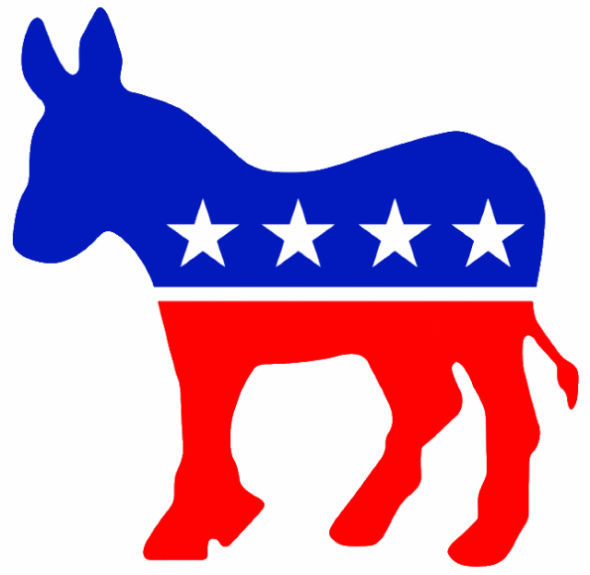Will Democrats Set Record for Governor Race?
A record 16 candidates have registered, making predictions difficult.

DemocraticLogo” by Source. Licensed under Fair use via Wikipedia.
You’re a Democrat planning to run for governor? Take a number. The line forms on the left.
Last week, 16 Democrats had registered with the state Elections Commission to challenge two-term Republican Gov. Scott Walker in the November 2018 general election.
If only 10 of them end up on the August primary ballot, it would be a record for modern Wisconsin politics, according to a review of Democratic primary elections going back to 1978.
That review shows there have been only six competitive Democratic primaries for governor since 1978, and most of those contests had only three or four serious candidates. This time, there could be eight or 10 Democrats with past political experience, or enough cash to get their message before voters.
The record number of Democratic candidates for governor, and the inability to predict how Walker and President Donald Trump will unify Democrats, means nobody – in or out of politics – can predict Walker’s opponent in November 2018.
Another wild card is the primary turnout, which ranged from 218,900 Democratic votes in 1998 to 665,800 in 2012. With up to 10 serious candidates possible, every vote in the August primary will matter.
So, consider something that can be measured: In those last six competitive Democratic primaries for governor, where did the votes come from? Did they come from the party’s traditional Madison and Milwaukee power bases?
Ten of the 16 registered Democratic governor wannabes have listed Dane County campaign addresses, even though one of them – Rep. Dana Wachs – has an Eau Claire voting address. Two of the 16 – Andy Gronik and Matt Flynn – are from Milwaukee County.
There have been wide fluctuations since 1978 in where Democratic votes In gubernatorial primaries come from:
*Milwaukee County’s Democratic vote totals in primaries for governor ranged from 32.4 percent of the statewide total in 2014 (Dane County Democrats Mary Burke and then-Rep. Brett Hulsey) to 17.9 percent in 1998 (Dane County Democrat Ed Garvey versus then-Milwaukee Sen. Gary George).
*Dane County’s Democratic turnout ranged from a high of 23.7 percent of the statewide turnout in the 1998 primary to a low of 10.6 percent in both the 1982 (Tony Earl, Martin Schreiber and James Wood primary won by Earl) and 1978 (David Carley versus Schreiber contest won by Schreiber) primaries.
*Waukesha County, a Republican stronghold, still cast more than 5 percent of Democratic votes in primaries for governor three times – the 2012 recall, in 2002 (the contest between Barrett, Atty. Gen. Jim Doyle and Dane County’s Kathleen Falk that Doyle won) and in 1982. In the other three primaries, Waukesha County Democrats cast only 3 percent of the statewide total.
*Racine County Democrats cast a high of 5.5 percent of the statewide total in the 1978 primary and a low of 2.4 percent in the 2014 primary.
*Rock County Democrats cast 4.6 percent of all statewide primary votes in 2014, and about 2.9 percent in the 2012 and 2002 contests.
*Brown County Democrats were responsible for a high of 3.9 percent of the statewide total in the 2012 recall and a low of 2.4% in 2014 and 1998.
*Kenosha County Democrats cast between 3.3 percent (1982) and 1.8 percent (2014) of the statewide totals.
Would a historical 10-candidate August primary be good for the State Democratic Party?
“The more, the merrier,” says ex-state Democratic Party Chair Joe Wineke, a former Dane County lawmaker whose career included primary losses. “The cream will rise.
Because state Superintendent of Public Instruction Tony Evers has won statewide elections, Wineke said Evers has a “clear advantage.”
But, Wineke added, “Dana Wachs and (State Fire Fighters Association President) Mahlon Mitchell have a chance to win the primary.”
“Money will matter in the primary, but not be the only indicator,” Wineke says. “Someone will come out of the January [fund raising] numbers looking surprisingly well, and a few candidates will look ridiculous. The winning candidate needs to raise several million in the primary and – more importantly – create a message that resonates with people.
Although Walker will outspend the Democrat, 2018 will be an anti-Trump “wave year,” Wineke predicted.
“The Democratic nominee for governor can get outspent $2 or $3 to $1 and still have a chance. That is doable.”
Steven Walters is a senior producer for the public affairs channel WisconsinEye. Contact him at stevenscwalters@gmail.com
Political Contributions Tracker
Displaying political contributions between people mentioned in this story. Learn more.
- August 16, 2018 - Tom Barrett received $50 from Andy Gronik
- December 21, 2017 - Tom Barrett received $400 from Martin Schreiber
- November 13, 2017 - Tom Barrett received $100 from Matt Flynn
- June 22, 2017 - Tom Barrett received $200 from Andy Gronik
- May 25, 2017 - Tom Barrett received $250 from Andy Gronik
- May 16, 2017 - Tom Barrett received $400 from Matt Flynn
- January 30, 2016 - Tom Barrett received $1,000 from Martin Schreiber
- January 27, 2016 - Tom Barrett received $400 from Martin Schreiber
- December 28, 2015 - Tom Barrett received $500 from Matt Flynn
- July 21, 2015 - Tom Barrett received $50 from Tony Earl
The State of Politics
-
A Wisconsin Political Trivia Quiz
 Dec 15th, 2025 by Steven Walters
Dec 15th, 2025 by Steven Walters
-
The Fight Over Wisconsin’s House Districts
 Dec 8th, 2025 by Steven Walters
Dec 8th, 2025 by Steven Walters
-
The Battle Over On-Line Betting
 Nov 24th, 2025 by Steven Walters
Nov 24th, 2025 by Steven Walters


















